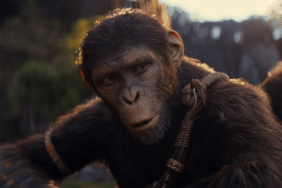After an ill-conceived remake from Tim Burton in 2001, 20th Century Fox decided to take another stab at bringing their beloved “Planet of the Apes” franchise into the 21st century. The result is Rise of the Planet of the Apes, a complete reconception of the sci-fi series that seeks to tell a palpable origin story for our planet becoming dominated by super-intelligent apes.
The whole thing begins with an ambitious scientist named Will (James Franco) earnestly trying to cure Alzheimer’s disease by testing a compound that repairs brain functioning. The road to hell is paved with good intentions, and one of his ape test subjects named Caesar matures emotionally and mentally at an astonishing rate, which leads to complications of global proportions.
Playing Caesar is Andy Serkis, the wizard of performance capture who created brilliant characterizations of Gollum and King Kong for Peter Jackson, and now brings us an ape of a whole different color. We chatted one-on-one with the master synthespian about his work on this film, Steven Spielberg’s The Adventures of Tintin, and his current work on “The Hobbit” films:
ComingSoon.net: Through this technology we’ve had actors play creatures, robots, animals, 5 different parts, completely different body types. You’re better qualified than anyone to say where this is going. What’s the next step, or the next 8 steps, in the evolution of performance capture?
Andy Serkis: I think the significant changes have led towards the notion that it is a tool and it’s the transparent interface that allows actors to act with each other. That’s where we’ve got to. Whereas before, say on “Lord of the Rings,” I acted on set with the other actors but when it came to the motion capture I had to do it separately in a volume away from the live-action set. We’ve come through “Kong” where we used facial capture for the first time really significantly. Through the “Avatar” process, and “Tintin,” and we arrive at “Apes” where we can now shoot on a live-action set. The director’s standing there, we play the scenes together. I think it’s really significant. I hope that the technology becomes more and more invisible. Head-mounted cameras, there’ll be no more need for those anymore. It’ll just be, again, enabling the actor to have nothing standing between them and a pure performance. Now, what I think we will eventually start to do is to be able to play amazingly different types of characters. I think it really is a portal into the whole video game world and storytelling in the next 10, 20, 30 years time. That’s what I’m looking forward to, how we’ll receive stories in 30 years time. How will we populate those stories? I think performance capture is going to play a really important part in it. You can play not just humanoid characters like Gollum and Caesar, but much more ethereal characters, more abstract characters. Performance capture not just on live-action sets but in live-theater it’s going to be really important. Working with contemporary dance companies or rock festivals or multimedia events where you can project real-time avatars in 3D. It really is the beginning of a new world. What we need to do is have an understanding from the entire acting community about what it is. That’s what’s holding us up. It’s embracing the technology. Any kind of filmmaker who says, “I’m not gonna move away from 35mm and start using digital!” We’ve got to lose that mentality in the acting fraternity and embrace the tool for what it is, which is this liberating medium that allows you to play anything.
CS: Just to clarify, for “Apes” they didn’t shoot any blank plates without you there with James Franco and the other actors?
Serkis: Every single shot was covered, Rupert then cuts his movie with our performances on screen. It’s obviously not ’til six or eight months down the line when the visual effects shots start to come in and they overlay the performance of Caesar on top of what I did on the day. The whole of the journey of Caesar is created without any dialogue so there are no clues there. It’s all to do with facial expression, body language, and what’s going on between the actors on set.

CS: A lot of that is James reacting to you actually being there.
Serkis: Precisely.
CS: So every take we saw in the film, you were in that take. That seems like the big leap of this film.
Serkis: That isn’t to say that wasn’t happening on “Lord of the Rings,” except it was done in a slightly different way. I acted on the set with all the other actors, then it went one of two routes. It was either rotoscoped if there was a lot of interaction, for instance if I was grabbing Frodo’s cloak they would paint frame-by-frame the old rotoscope way over that. Or they would shoot live plates and I would shoot on the performance capture stage. “Apes” was getting it all in one go, basically.
CS: On “King Kong” you spent a lot of time with real chimps and gorillas in their natural habitat, and obviously you carried some of that experience over to this one, but what helped you the most on this film?
Serkis: Having that underlying knowledge and experience was great. In fact, when I’d gone to Rwanda to study mountain gorillas I did spend some time with an orphaned infant chimpanzee that I actually played with and rolled around with.
CS: Not unlike Caesar.
Serkis: Not unlike Caesar. Very innocent, young. He was like playing with a kid, just amazing. That was certainly something that played into it. So I was able to plug back in to using arm extensions much like I did on “Kong” for the quadruped stuff. Actually, what then became important was to, like on “Kong” but in a completely different way, really find out who this personality in the character of Caesar was. For that I looked to a real chimpanzee called Oliver who in the 1970’s came to prominence. He was known as the “Humanzee” because people believed he was a hybrid between an ape and a human, that he was a missing link. He was a bipedal chimpanzee reared by humans, who when he walked into the room people were utterly shocked because he had facial expressions like a human, his rhythm, the way he walked, sat down, picked up a glass or drank. There were a lot of scientific experiments to prove his heritage and his DNA. Even when he reached sexual maturity he made advances on his carer. Yeah. He was a really extraordinary character, Oliver. You can see him on YouTube.
CS: There is a striking moment when your posture as Caesar is the same as James Franco’s, and it’s such a subtle transition.
Serkis: That’s right. We had to chart that. Rupert and I were very specific about when he goes bipedal, when he starts to straighten up more and more, so by the end of the film he’s pretty upright.
CS: Does inhabiting that behavior, those traits, is that infectious? Does it carry over into your real life?
Serkis: Oh, absolutely! For sure, you do find yourself doing things with your hands during production. The way you pick things up is slightly different. You’re all the time trying to train that emotional muscle memory to operate in that way. My whole weight dropped into my hips and opened up more.

CS: There are many nods to the original “Apes” movies, including a cameo from the Statue of Liberty, but what did you specifically admire about Roddy McDowall’s performances?
Serkis: Roddy McDowall honored the notion that he was a humanoid, evolved ape. He played him, in many respects, his entity, his whole feel was to play him human.
CS: Very erudite.
Serkis: Yeah. Obviously in those films there was that hierarchical structure where the orangutans were the lawmakers, the gorillas were the military and police force, and the chimps were the intellectuals and artists. That is what we’re heading towards. I wasn’t necessarily trying to emulate anything that he did, because with Caesar he’s primarily a chimpanzee who’s confused because he has this enhanced intelligence, but he’s more the animal we know than the thousands of years of evolved apes we know from that original.
CS: The big difference between this Caesar and that Caesar seems to be that theirs was coming at things from an intellectual point of view, whereas this one responds from an emotional place.
Serkis: Absolutely. The intelligence drug that affects Caesar isn’t just affecting his cognitive skills, it is affecting his emotional intelligence as well, his ability to empathize.
CS: I love that you’re segueing into directing, and you just worked with the big kahuna, Mr. Spielberg on “Tintin.” What is something when you were working with him that really threw you for a loop, something about that guy that maybe the general public doesn’t understand?
Serkis: Steven was working with performance capture technology for the first time, so in a way he was working outside of his comfort zone…
CS: And in yours.
Serkis: It was, and we did a lot of tests before principal photography on “Tintin,” but Steven is, as we know, a visionary director who always wants to push the envelope. The fact that he accessed performance capture technology to bring “Tintin” to life was clearly a brilliant idea. It couldn’t be better in terms of bringing Hergé’s artwork and sensibility and palette and color and energy of his drawings to life. They’re photorealistically rendered, but they have the urgency and immediacy of live-action performances. I’ve been used to shooting performance capture where you shoot long, extended scenes. You’re not really worried about camera moves because…
CS: You can get it in post.
Serkis: You can do it in post, use a virtual camera and shoot it after-the-fact, but Steven wanted to shoot it more conventionally. He wanted to shoot it like a live-action movie in the volume, and I think that’s the first time a director’s really done that.
CS: I know he’s admittedly a very intuitive director. Did you get a sense of how that mechanism of intuition works?
Serkis: Absolutely. He was able to absorb this new technology, looking into a virtual camera and watch actors in motion capture suits over there, standing in the space, but on the screen be looking into a video game-type monitor with a lit, rendered set, low-res. He was having to martial all of these things and that’s certainly a challenge for any director. He knocked it out of the ballpark.

CS: You’ve directed several small short films, but it must be like getting handed the keys to the kingdom directing 2nd Unit on “The Hobbit.” With all those resources at your disposal, what doesn’t change from doing a low budget short to a $500 million dollar film?
Serkis: It’s really incredible. At the end of the day you’re finding the right shot to support the performance. That’s something I’ve learned from working with Peter over the years. What I’ve loved and really connected with is observing his choices in how to tell a story with a camera. I’ve been very inspired by the way he works over the years, clearly, and I think that’s why I feel like I’m kind of in touch with his sensibility. Although I’m there for him on 2nd Unit, his words to me when he offered me the job were, “I want you to make bold decisions, come back with your own take on it, you can cut your own material.” He wants a fresh pair of eyes as well. I’m not gonna take it too far from his sensibility, but to have that creative freedom and yet at the same time know that you’re aiming towards the same end is a great mix for working on that scale. Working in 3D for the first time, working with such a big crew, all the drama and battle sequences and all the other things.
CS: Will what you do next be somewhere in the middle or do you want to direct big films like this?
Serkis: I think, yeah. Look, it’s all about story and characters, so for me if the story demands a smaller, low-budget approach then I’ll do that. If it needs a bigger palette, a lot more money, I think I’m equipped to do that too.
Rise of the Planet of the Apes opens in theaters on Friday, August 5th.
(Photo Credit: WENN.com)









